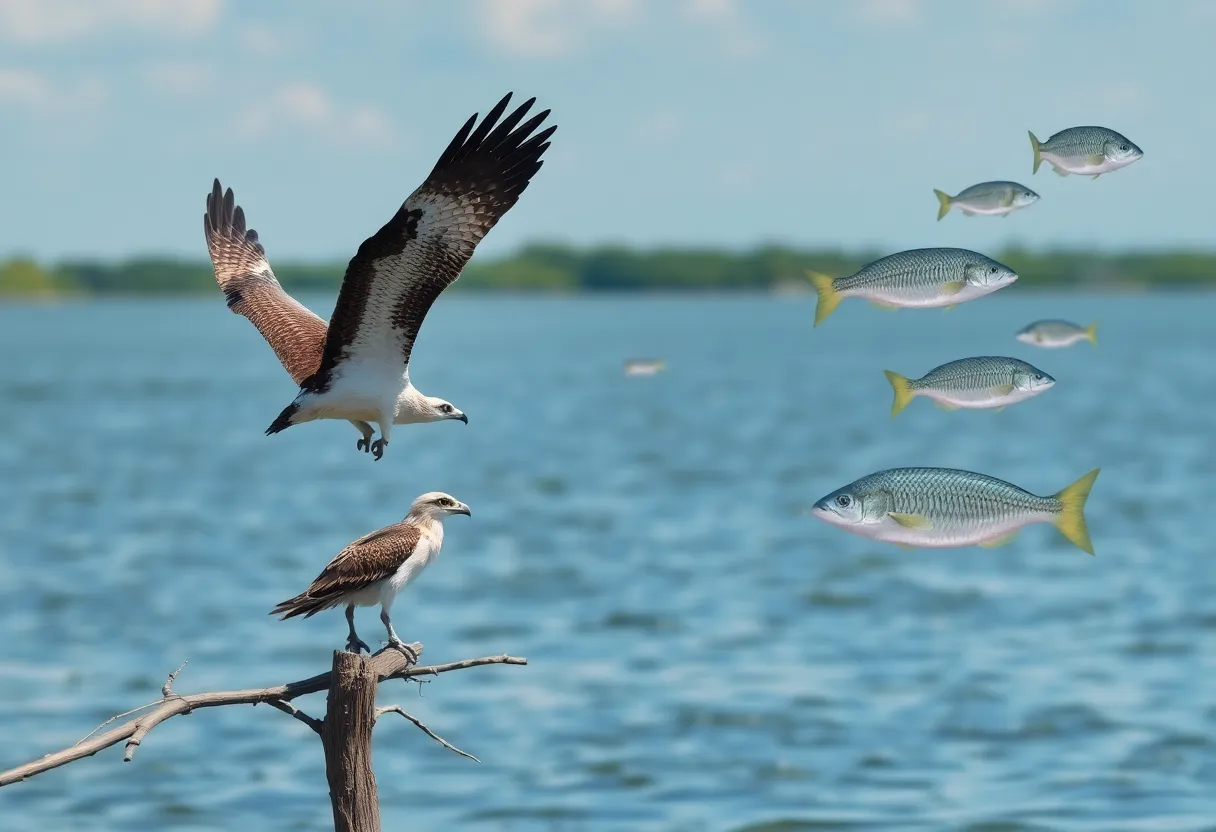News Summary
Osprey fertility rates are alarming in the Chesapeake Bay, with a significant decline attributed to decreasing menhaden populations. This has sparked concerns among conservationists and fishing industries, highlighting the need for effective management strategies. Recent findings reveal troubling breeding trends and increased nest predation by minks, marking a critical juncture for osprey conservation efforts in the region.
Gloucester Point, Virginia – The fertility rates of ospreys, a bird species known for its fish-eating habits, are showing alarming signs of decline in the Chesapeake Bay area, largely correlated with decreasing populations of menhaden, a crucial fish in their diet. Bryan Watts, a research professor and director of the Center for Conservation Biology at The College of William & Mary, reported observing a failed osprey nest this June on the Lower York River, signaling a worrying trend noticed over recent years where ospreys have not laid eggs in significant numbers.
The failure of this particular nest, which has now been claimed by diving terns, exemplifies a broader issue facing the osprey population. While ospreys were once under threat, their numbers rebounded significantly after DDT was banned in 1972, reaching the thousands across the United States. However, the recent findings indicate a troubling decline in successful breeding and chick survival within the Chesapeake Bay region.
Watts suggests that the drastic drop in menhaden populations is directly impacting the reproductive success of ospreys. As menhaden are especially nutritious for fledgling chicks, their scarcity leads to starvation and a reduction in nest success. The need for a stable reproductive success rate of 1.15 chicks per year for ospreys to maintain population levels is not being met. In some areas of Chesapeake Bay, average fledging rates are reported to be less than one-tenth of that required rate, sparking concerns among conservationists about a potential decline reminiscent of pre-DDT conditions.
The fishing industry finds itself in a contentious debate with environmental groups regarding the causes behind the declining osprey population. Menhaden is commercially valuable, being a key resource for fish oil, fish meal, agricultural feed, and bait for recreational fishing. Since 1951, fishermen have consistently harvested over 1.1 billion pounds of menhaden annually. Industry representatives have countered claims linking their fishing practices to the decline of ospreys, pointing to alternative factors such as climate change and pollution that may also be contributing to the problem.
In response to the alarming data on osprey populations, the Association of Atlantic States Marine Fisheries Commission has proposed management strategies aimed at regulating menhaden fishing. Despite conservation pressures emphasizing adjustments in fishing practices, frustration is growing within the fishing community, with labor leaders feeling unfairly targeted for the declining osprey numbers.
Adding to the complexity of the situation, recent research indicates that minks have begun raiding osprey nests, further complicating conservation efforts. Minks are known to prey on osprey eggs and chicks, increasing the threats that these raptors face, alongside declining food availability.
For effective conservation of the osprey population, focused interventions are deemed necessary. Without a concerted effort to address both the availability of menhaden and the impact of new predators like minks, the continued success of these raptors may be jeopardized. This situation has raised alarms not only among conservationists concerned about wildlife preservation but also among those advocating for sustainable fishing practices to safeguard the intricate ecological balance in the Chesapeake Bay.
Deeper Dive: News & Info About This Topic
HERE Resources
Chesapeake Bay Osprey Population Decline Linked to Menhaden Shortage
Virginia Ospreys Face Decline Due to Menhaden Shortage and New Nesting Threats
Declining Osprey Populations in Virginia’s Chesapeake Bay
Additional Resources
- Los Angeles Times
- Wikipedia: Osprey
- MSN News
- Google Search: Osprey Population Decline
- Tribune Democrat
- Google Scholar: Osprey Chick Survival
- Chesapeake Bay Magazine
- Encyclopedia Britannica: Osprey

Author: STAFF HERE VIRGINIA BEACH WRITER
The VIRGINIA BEACH STAFF WRITER represents the seasoned team at HEREVirginiaBeach.com, your trusted source for actionable local news and information in Virginia Beach, Virginia Beach City, and beyond, delivering "news you can use" with comprehensive coverage of product reviews for personal and business needs, local business directories, politics, real estate trends, neighborhood insights, and state news impacting the region—supported by years of expert reporting and strong community input, including local press releases and business updates, while offering top reporting on high-profile events like the Virginia Beach Neptune Festival, East Coast Surfing Championship, and military homecoming celebrations, alongside key organizations such as the Virginia Aquarium, Virginia Beach Convention Center, and Oceana Naval Air Station, plus leading businesses in tourism and defense like Busch Gardens and Northrop Grumman, and as part of the broader HERE network including HEREWilliamsburg.com, providing credible, in-depth insights into Virginia's vibrant landscape. HERE Virginia Beach HERE Williamsburg





